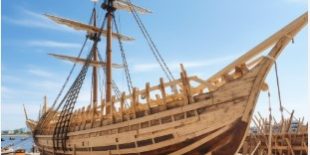The Relationship Between Wood and Shipbuilding: A Historical and Modern Perspective
Wood has played a vital role in shipbuilding for centuries, especially in ancient and early modern times, when it was the primary material used for constructing ships. Even today, despite the widespread use of metals and composite materials, wood remains an essential material for certain types of ships, particularly traditional wooden vessels and high-end smaller boats. This article explores the historical significance of wood in shipbuilding, its advantages and disadvantages, and the ongoing role of wood in modern ship construction.
- Historical Background
Wood has been the foundation of shipbuilding for millennia. Ancient maritime civilizations such as the Egyptians, Greeks, and Romans used wood to build ships that supported sea trade, exploration, and warfare. Ships like the Viking longships, Christopher Columbus’ “Santa Maria,” and ancient Chinese warships were all constructed from wood.
During the Age of Sail, wood was the dominant material for large ships. The durability, flexibility, and ease of shaping made it an ideal choice for ship hulls, masts, and decks. Even the famous “HMS Victory,” the British ship that defeated Napoleon at the Battle of Trafalgar, was built entirely from wood.
- Wood Selection for Shipbuilding
Different types of wood have been used in shipbuilding over the centuries, chosen based on their characteristics, such as strength, density, water resistance, and durability. Commonly used woods in shipbuilding include:
- Oak: One of the most widely used woods in shipbuilding, oak is known for its strength and resistance to water. It is often used for the ship’s frame and hull.
- Cedar: Known for its natural resistance to rot and insect infestation, cedar has long been favored for smaller boats and decking.
- Teak: Highly prized for its durability, teak is used in luxury yachts and boating decks due to its resistance to water, rot, and wear.
- Belian Wood: This Southeast Asian hardwood is gaining attention for its strength, durability, and water-resistant properties, making it an excellent choice for ship hulls and marine infrastructure.
- Advantages of Wood in Shipbuilding
Wood has several advantages that made it the preferred material for shipbuilding for centuries:
- Buoyancy and Weight: Wood’s natural buoyancy allows it to float, providing a lighter and more maneuverable vessel.
- Workability: Wood is relatively easy to work with, allowing shipbuilders to shape, cut, and assemble the materials to create complex designs.
- Strength and Flexibility: The natural flexibility of wood helps ships absorb impacts and stresses, reducing the risk of damage.
- Disadvantages of Wood in Shipbuilding
Despite its many advantages, wood does have some limitations, particularly in comparison to modern materials:
- Durability Issues: Wood is vulnerable to water, humidity, fungus, and termites, which can weaken the structure over time. Regular maintenance and treatment are required to ensure its longevity.
- Maintenance Costs: Wooden ships require constant care, including re-painting, re-sealing, and re-treating the wood to maintain their integrity.
- Weight: While wood is buoyant, the sheer volume needed for larger ships can add significant weight, making them less efficient than modern metal ships.
- Modern Applications of Wood in Shipbuilding
In modern times, while metals and composites dominate the shipbuilding industry, wood is still used in certain areas:
- Traditional Wooden Vessels: Wooden ships, including sailing yachts and classic vessels, are still built for enthusiasts and collectors who appreciate the craftsmanship and aesthetic of traditional shipbuilding methods.
- Tourism and Eco-Friendly Vessels: In eco-conscious travel, wooden boats are sometimes used for river tours, wildlife observation, or in protected areas where blending with the natural environment is desired.
- Small Craft and Handcrafted Boats: Wood remains a popular material for the construction of smaller boats and custom-designed vessels, particularly in regions where traditional boat-building skills are passed down through generations.
- Wood’s Continuing Role in Shipbuilding
Today, wood is still seen as a prestigious material in the creation of high-end, custom ships and yachts. In particular, companies like Creatimber Global Sdn Bhd are championing the use of high-quality, sustainable wood such as Belian and Teak for shipbuilding, offering eco-friendly solutions for both traditional and modern maritime projects. Their expertise in sourcing and processing premium woods ensures that wood remains a viable and sustainable choice for specialized boatbuilders and ship owners worldwide.
- Conclusion
Wood has a long and storied history in shipbuilding, from the great wooden ships of the ancient world to the high-end yachts of today. Despite the rise of metals and composites, wood continues to be an essential material in certain niches, especially for traditional and luxury vessels. Its combination of strength, beauty, and environmental compatibility, when sourced responsibly, ensures that wood will remain a valuable material in shipbuilding for years to come. Whether through sustainable sourcing or companies like Creatimber Global Sdn Bhd, which prioritize quality and ecological impact, wood’s legacy in shipbuilding endures. For more infomation please visit www.creatimber.com.my






